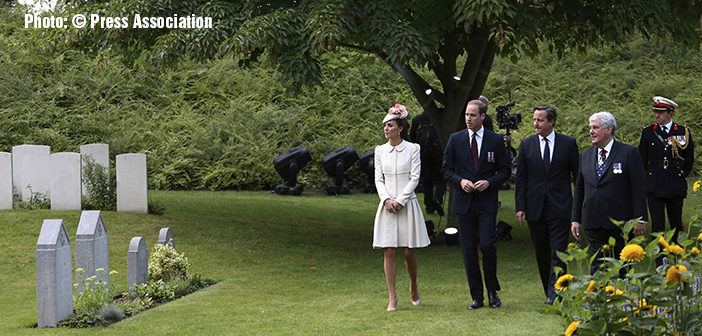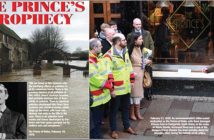The Remembrance at Mons, Belgium, marked a century on from the Battle of Mons, the first clash between British and German forces in World War One. A commemoration service was held at Saint Symphorien Military Cemetery, outside the town of Mons, Belgium. More than five hundred guests joined King Philippe and Queen Mathilde of Belgium, the Duke and Duchess of Cambridge and Prince Harry to pay tribute to the fighting forces of The Great War and their sacrifice in the conflict that saw around 9.5 million soldiers lose their lives.
Amongst the speakers at the ceremony was Prince Harry who read from a letter sent by Private Michael Lennon, of 1st Battalion, the Royal Dublin Fusiliers, the day before he landed at Gallipoli in June 1915: “Well Frank, I suppose we are for it tomorrow, if we don’t get shelled on the way. I can only hope that we have all the luck to come through the night and if I should get bowled out – well it can’t be helped.” Alongside Prince Harry, British PM David Cameron paid tribute to the “ . . . young men across this continent [who]packed their kit bag, kissed their sweethearts goodbye and prepared to go to war. I think of the millions of mothers and fathers who would have stood on their front door-step, waving their sons off, not knowing if they would ever see them again.”
The theme of the commemoration service was reconciliation, in which Saint Symphorien Military Cemetery itself has a poignant role, being the burial site for both British and German soldiers.

(Top left) The rulers of the Axis Powers: Kaiser Wilhelm II of Germany, Ottoman Emperor Sultan Mehmed V and Emperor Franz Josef of Austria-Hungary. (Top right) Kaiser Wilhelm II and Kaiserin Augusta Victoria. (Bottom left) World War One began with Austria-Hungary’s attack on Serbia, which drove the Serbian army southward in a desperate retreat. (Bottom right) Excerpt from ‘The Romanovs,Love, Power & Tragedy’.
Amongst the VIP attendees was Germany’s President Joachim Gauck who spoke of the “completely unjustifiable” invasion of Belgium – “Nationalism had blinded almost everyone’s hearts and minds.” His comments were a reminder of the driving factors behind a conflict which caused suffering on a hitherto unimaginable scale and led to the fall of governments across Europe and the redrawing of its borders. Germany’s Kaiser Wilhelm II has often been seen as one of the most foolhardy of Europe’s leaders but the march to war was far from being Germany’s responsibility alone.
World War One saw the destruction of empires (the German, Austro-Hungarian and the Ottoman) and in the deluge many of Europe’s monarchies were swept away: in Russia the Romanovs were overthrown and executed, Kaiser Wilhelm II was forced into exile, as was the last of the Austro-Hungarian Habsburgs , Charles I. And for the continent’s surviving monarchs, such as the British, the future seemed uncertain with the threat of revolution apparently close at hand.

(Above left) Amidst the horrors of WWI, Britain’s King George VI presents medals as General Douglas Haig looks on. (Above right) Russia’s Tsar Nikolai II and his son, Tsarevich Alexei, at Army HQ on the banks of the River Dnieper. (Inset) How the British press reported the war struggle of the Kingdom of Montenegro.
The centennial commemorations of World War One will continue throughout the year and, indeed over the coming four years as world leaders, heads of state and millions around the world join together in remembrance and honour of the fallen.

The Fall of Eagles chronicled in (above left) ‘Nikola & Milena: King & Queen of the Black Mountain’ and (above right) ‘The Romanovs: Love, Power & Tragedy’.





